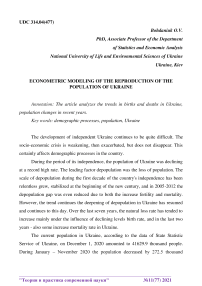Econometric modeling of the reproduction of the population of Ukraine
Автор: Bohdaniuk O.V.
Журнал: Теория и практика современной науки @modern-j
Рубрика: Основной раздел
Статья в выпуске: 11 (77), 2021 года.
Бесплатный доступ
The article analyzes the trends in births and deaths in Ukraine, population changes in recent years.
Demographic processes, population, ukraine
Короткий адрес: https://sciup.org/140275876
IDR: 140275876 | УДК: 314.04(477)
Текст научной статьи Econometric modeling of the reproduction of the population of Ukraine
The development of independent Ukraine continues to be quite difficult. The socio-economic crisis is weakening, then exacerbated, but does not disappear. This certainly affects demographic processes in the country.
During the period of its independence, the population of Ukraine was declining at a record high rate. The leading factor depopulation was the loss of population. The scale of depopulation during the first decade of the country's independence has been relentless grew, stabilized at the beginning of the new century, and in 2005-2012 the depopulation gap was even reduced due to both the increase fertility and mortality. However, the trend continues the deepening of depopulation in Ukraine has resumed and continues to this day. Over the last seven years, the natural loss rate has tended to increase mainly under the influence of declining levels birth rate, and in the last two years - also some increase mortality rate in Ukraine.
The current population in Ukraine, according to the data of State Statistic Service of Ukraine, on December 1, 2020 amounted to 41629.9 thousand people. During January ‒ November 2020 the population decreased by 272.5 thousand people. The excess of the number of deaths over the number of live births remains significant: 49 live births per 100 deaths (Table 1).
Table 1
Basic demographic indicators
(persons)
|
Indicators |
January ‒ November 2020 |
January ‒ November 2019 |
|
Population available (estimated) on December 1 |
41629926 |
41922670 |
|
The average population of January ‒ November |
41766171 |
42037936 |
|
Permanent population (estimated) on December 1 |
41460289 |
41753033 |
|
The average permanent population in January ‒ November |
41596534 |
41868299 |
|
Total increase, decrease (-) of population |
–272490 |
–230531 |
|
Natural increase, reduction (-) of population |
–280273 |
–246987 |
|
Number of live births |
268899 |
286777 |
|
Number of deaths |
549172 |
533764 |
|
of them children under 1 year |
1812 |
2043 |
|
Migration growth, population reduction (-) |
7783 |
16456 |
Population decline due to the number of deaths exceeding the number of births and the concomitant acceleration of demographic aging is currently becoming one of the most pressing and acute demographic problems not only in Ukraine but also in many European countries.
The demographic situation in different regions of Ukraine is not the same, the birth rate in the regions, according to our calculations, directly depends on the population. Econometric modeling of the influence of population on fertility in 24 regions of Ukraine, Fig. 1, indicates the average strength of the relationship between the indicators.
вывод итогов
|
[ Регрессионная статистика |
||||||
|
Множествен 0,601113914 |
||||||
|
R-квадрат 0,361337938 |
||||||
|
[Нормирован 0,315719219 |
||||||
|
[Стандартная 4,302 |
||||||
|
[Наблюдения 16 |
||||||
|
[Дисперсионный анализ |
||||||
|
df |
55 |
MS |
F |
ючимость |
F |
|
|
[Регрессия 1 |
1,47Е+О8 |
1,47Е+О8 |
7,920826 |
0,013784 |
||
|
[Остаток 14 |
2,59Е+08 |
18512029 |
||||
|
[Итого 15 |
4,0 6 Е+08 |
|||||
|
Коэффициенты |
артная ot |
татисти |
’-Значение |
ижние 95° |
ерхние 955 |
окние 95, 0‘рхние 95, О% |
|
[У-пересечен! 6319,120121 |
2516,271 |
2,511303 |
0,024916 |
922,2546 |
11715,99 |
922,2546 11715,99 |
|
Переменная 0,003556495 |
0,001264 |
2,814396 |
0,013784 |
0,000846 |
0,006267 |
0,000846 0,006267 |
Fig. 1. Econometric modeling of the reproduction of the population of Ukraine
According to fig. 1, the multiple correlation coefficient is 0.6, which indicates the average relationship between the indicators, the multiple coefficient of determination is 36%, therefore, the variation in the birth rate in the region by 36% due to variation in the population of the region.
Fisher's F-test is an actual value greater than the tabular value, and therefore, the multiple coefficient of determination is significant. Student's test criterion also indicates the significance of the parameters of the regression equation. Accordingly, the equation of linear regression dependence is represented as:
ух = 6319,12 + 0,004х, where: y is the birth rate, million people;
x1 - population, million people.
In general, Ukraine continues to reduce fertility, and given the significant economic, political, social problems in our country, as well as the epidemiological danger, it is unlikely to expect a radical reversal of this trend (although there is no denying the possibility of short-term slight increase in birth rates due to 0.9–1.5 years after the end of the coronavirus epidemic). The process of shifting the birth rate to older age is also continuing women, which is confirmed not only by the increase in the average age of the mother at birth (both for all births and firstborns), but also the shift in leadership in the intensity of childbirth from women aged 20-24 to older women aged 25-29 years, and increasing the proportion of children born to middle- aged and older women of reproductive age. Along with this is happening reduced fertility in women aged 15-19 years.
Список литературы Econometric modeling of the reproduction of the population of Ukraine
- http://www.ukrstat.gov.ua
- Стан здоров'я народу України. Новi загрози та виклики / пiд ред. Коваленка В.М., Корнацького В.М. - К.: Державна установа "Нацiональний науковий центр "Iнститут кардiологiї iменi акад. М.Д. Стражеска", 2020. - 198 с.
- Policy Brief: COVID-19 and the Need for Action on Mental Health (13 May 2020). https://www.un.org/sites/un2.un.org/files/un_policy_ brief-covid_and_mental_health_final.pd


